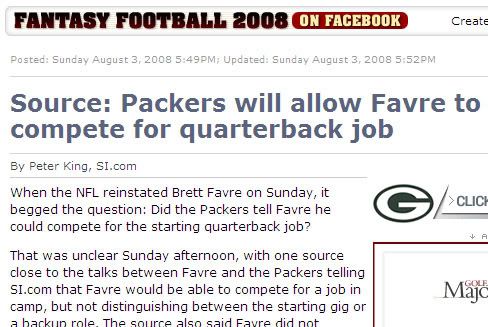Like it or not, fantasy football is important. According to the New York Times, 15.5 million people play fantasy football each year - about 86% of which are are male and 63% are under age 40. It's also become a $2 billion industry.
So when Sports Illustrated (SI.com) moved their fantasy football to Facebook, two things became apparent:
1) Sports Illustrated isn't the leader in fantasy football and is trying to aggressively catch up
2) Facebook has become completely mainstream and, for the big brands, an avenue for user acquisition (important to note that fantasy football is comprised heavily of adult males as well - so SI is using Facebook to acquire users outside of high school / college)
Sports Illustrated, according to TheBigLead and Comscore, was the ninth most visited sports network on the web... and in fantasy football, Yahoo, ESPN and CBS are the clear leaders. Here are the stats from the last month:
1. Yahoo Sports: 22,752,000 uniques
2. ESPN: 20,601,000 uniques
3. Fox Sports: 15,105,000 uniques
4. MLB.com: 11,917,000 uniques
5. AOL Sports: 10,632,000 uniques
6. WWE: 6,759,000 uniques
7. NBA: 5,740,000 uniques
8. NFL Internet Group: 5,624,000 uniques
9. Sports Illustrated Sites: 4,492,000 uniques
10. NASCAR.com: 3,528,000
Fantasy sports are critical for the major sports networks because they are remarkably sticky, have high switching costs and attract clusters of users. So for Sports Illustrated to run their fantasy offering offsite is very surprising a clear sign (to me) that they are conceded the fantasy game - hoping to win a new market via Facebook's huge audience. It's an interesting effort and perhaps not overly risky considering their position in the market... But unlike CBS's smash hit with the Final Four / Facebook integration, this doesn't seem to have a clear proposition to get users back to SI.com.
Meanwhile, this seems like a big win for Facebook - just as the CBS / March Madness relationship was.
Notice the Facebook promotion atop the story headline

The Application's front door



